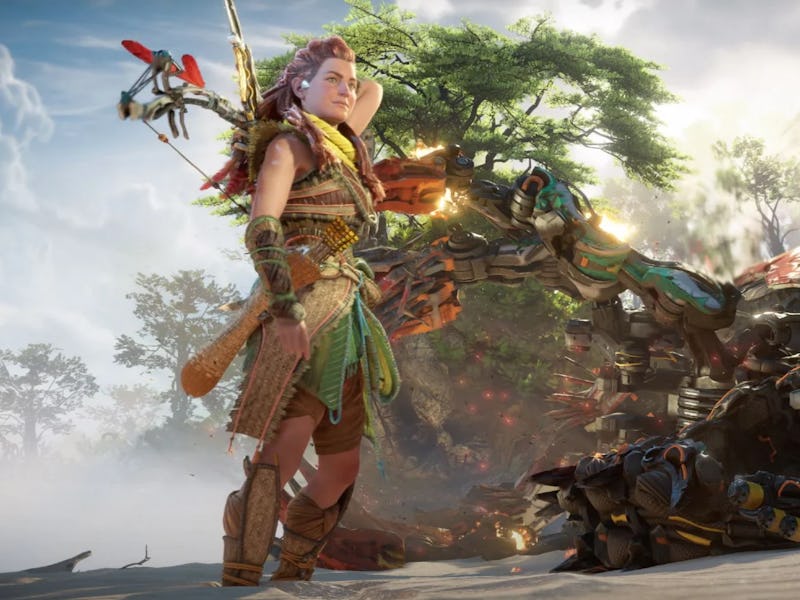PlayStation's biggest next-gen disappointment isn't really so bad
Who does cross-gen benefit?

Sony published a PlayStation Blog post on Wednesday indicating plans for many of its upcoming games. The post was comprised of an interview with Head of Sony’s Worldwide Studios Hermen Hulst, who noted that God of War 2 (or whatever it will be called), Horizon Forbidden West, and Gran Turismo 7 will all be available for PlayStation 4 in addition to PlayStation 5.
That seems like an inherent contradiction to Sony’s infamous “we believe in generations” perspective. Everyone wants to get the most out of their expensive new PS5 systems, but when new Sony-exclusive games are released on both platforms, that might diminish the quality of the product in general. Sony is able to reach more players this way, but it comes at the expense of limiting developers' creativity.
But first: What are your favorite games and platforms of 2021, and what future releases are you most excited about? Take our poll!
The perks of cross-gen
A PS5 system.
It’s still tough to get a PS5 system even seven months after launch. They routinely sell out within minutes. Supply remains a major issue.
So for Sony to bring these highly anticipated games to PS4 as well ensures that as many players as possible can experience the latest PlayStation games. After all, we’re talking about some of the most beloved PlayStation franchises of all time, so it stands to reason that Sony wants to get as many players playing the sequels.
If the follow-ups in these franchises were to only be released on PS5, fewer players would get to experience them. Sure, they’d look and run impressively on PS5, but if only a fraction of the community can play them, that’s a problem. Launching across multiple platforms leads to more sales, which makes sense from a business perspective.
But at what cost?
Limiting ambition
The new enemies in Horizon Forbidden West.
On the other hand, developing a cross-generational game can severely hinder the quality of the final product. In many cases, developers have to spend time “scaling back” projects to run on older hardware, taking precious time and resources away from the next-gen versions.
What ends up happening is that the version for the previous generation suffers in quality since the game might not have been designed for those platforms natively. Likewise, the next-gen version could be lacking as well because developmentally, it can’t live up to the full potential.
We’ve seen examples of this, most famously with Cyberpunk 2077, a game that was designed for modern hardware primarily. Developer CD Projekt RED then had to scale the project back to run on PS4 and Xbox One, which resulted in a buggy, unpolished product. It was so bad, Sony pulled the game from the PlayStation Store, and to this day, it cannot be purchased digitally.
In other cases, players simply want to get their money’s worth with their shiny new PS5 systems — and experience its true potential.
Developers may have to throw out ideas that are only possible on new hardware so the game at large can work on previous generations. The business side of game development can greatly impact the overall quality of the final product. Cross-generational releases are proof of that.
Sony’s contradiction
Sony began its PS5 marketing with the phrase “we believe in generations,” taking a stance against Microsoft’s approach towards cross-generational releases. As it stands, any Xbox game that releases in 2021 (or in the near future) will work on Xbox One and Xbox Series X|S, blurring the lines between generations. Even the next-gen console's user interface is borderline indistinguishable from the Xbox One.
“We believe in generations,” implies that Sony is making a clear distinction between PS4 and PS5. But the announcement that major first-party titles will still head to PS4 is a contradiction that muddles the company’s intent. There may have been ambitions to capitalize on the strength of the PS5, yet those have stalled in favor of good business sense.
Getting new PS5 systems into the hands of consumers has been a challenge, as parts to manufacture the machines have been scarce, and the demand for the system is through the roof. Is the growing priority of cross-gen the only consolation prize Sony can offer? Or was this always the plan?
One thing is certain: The mixed messaging is a bad look.
Sony knows its hardware better than anyone
A race in Gran Turismo 7.
The saving grace in this situation is that Sony knows its hardware better than anyone. This means Sony and its first-party teams like Polyphony Digital, Santa Monica Studio, and Guerrilla Games are the most equipped to develop cross-generational games that look, run, and play well on PS4 and PS5.
In a lot of cases, third-party developers like CD Projekt Red aren’t as familiar with the inner workings of system architecture when compared to a team that comes directly from Sony. The developers at Sony have better access to resources that can help move production along for games on PlayStation hardware. Teams won’t be spread as thin when they’re developing for a singular console ecosystem. Sony made the PS4 and PS5, so it makes sense that its teams would have an easier time creating games for those systems, especially when there’s inherent structural overlap between the generations.
With that in mind, the quality of Sony’s big upcoming first-party games will still likely be high, even on PS4. Sure, the PS5 versions of these games will have more bells and whistles, and might even include exclusive features. If Sony has proven anything in the past eight years or so, it’s that high quality is high on its priority list. But imagine a world where it abandoned PS4 entirely to focus on developing for the PS5’s greatest strengths. How might games like the God of War sequel and Horizon Forbidden West look then?